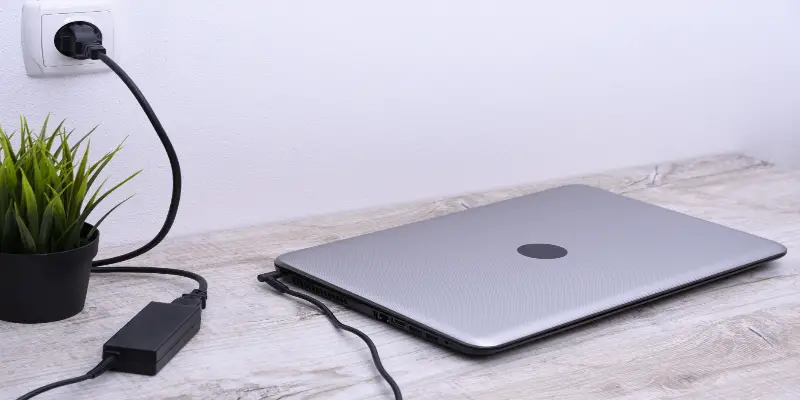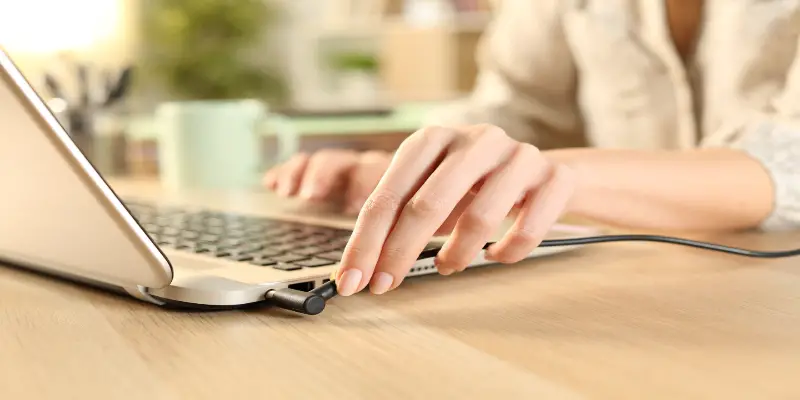Disclaimer: This post may contain affiliate links, meaning we get a small commission if you make a purchase through our links, at no cost to you. For more information, please visit our Disclaimer Page.
You may be wondering, is it OK to charge a laptop while it is off?
It’s okay to charge a laptop while it’s off because it helps the charging speed up. If it’s okay with you to wait for a longer time, charging the laptop while it’s turned on is also fine. But if you want to charge a battery in under an hour, a fast charger is a good option.
Table of Contents
Does a laptop charge faster when turned off?
A laptop charges faster when turned off because no program or software is running as you charge. You’ll need a power supply from the laptop to charge the battery and the program needs power too to operate. Because the battery and the programs share the power supply, it’ll be helpful if you turn off your laptop while charging.
But if you decide to keep your laptop on while charging, there’s no problem at all. It doesn’t take long for the battery to recharge even when you’re using your laptop.
If you can’t turn off your laptop while charging, close the unnecessary program that is running on your laptop in the background. You can manually close the programs on the task manager. In the Process Tab, close the apps and the background process that you’re not using at the moment. Closing the apps and background helps to increase the speed of charging.
Other factors in charging a laptop
You need to take note that there are other factors to consider when you charge a laptop. One of the factors is the amount of power supply that your laptop is getting. Some laptops can charge at a low wattage while some need a higher wattage. So, even if you turned off your laptop but it has no efficient power supply, it won’t charge.
Another thing to consider is the type of charger you’re using. If you’re using a fast charger, your laptop’s battery can charge up to 80% within half an hour.
However, you must take note that not all batteries are compatible to accept a fast charge. If you plan to buy a new laptop, you must check for that feature. If you already have a laptop and its battery can’t accept a fast charge, opt for the rapid charge.
Charger characteristics
According to Battery University, there are four characteristics of a charger including a slow charger, rapid charger, fast charger, and ultra-fast charger. The slow charger only applies to NiCd and Lead-acid batteries. The other chargers apply to NiMH, NiCd, and Li-ion batteries.
Rapid chargers sense battery by current, voltage, and temperature. It also has a time-out timer. A fast charger shares the same characteristic. However, a rapid charger can charge a battery between three and six hours while the fast charger can charge a battery for up to more than an hour.
On the other hand, an ultra-fast charger can charge from 10 minutes to one hour with a 70% state of charge.
Fast charger phases
Fast charging comes in two phases. Phase one aims to increase the charging rate of the battery so its battery level increases in a short period. To achieve a fast charging rate, you must increase the voltage. Through this phase, the power flow increases that helps the battery to receive the charge it needs.
After the completion of phase one, the voltage starts to decrease. This phase is important as it prevents the overcharging and overheating of the battery.
Fast charging is not dangerous for the battery as long as the battery is compatible with that type of charging. Yet, even if the battery is compatible with fast charging, you must take note that you need to avoid charging it for over 80% and a long period. It may produce heat, which can affect the battery’s health.
Although fast charging eliminates the long hours of charging a battery, it’s still advisable to use the charger that comes with your laptop. The laptop’s standard charger can keep the voltage constant.
Fast charging laptop models
New models of HP laptops are now fast-charging including HP Chromebook x360 convertible laptop, HP ENVY x2 detachable laptop, 3. HP EliteBook 850 G5 business laptop, HP Spectre x360 / Folio convertible laptops, and HP ZBook Studio G5 mobile workstation.
The fast-charge feature of these laptops allows the laptops to charge up to 50% in 45 minutes. When it comes to battery life, these laptops can run from 11 hours and 30 minutes up to 17 hours and 30 minutes.
Battery voltage
As a laptop user, you need to make sure that your laptop’s battery doesn’t get high voltage because it affects the battery’s life. A battery with a high voltage has a low discharge cycle, which means that the battery’s lifespan shortens over time. On the other hand, a battery with low voltage has a higher discharge cycle, which means that you can use the battery for years.
A battery with a charge level of 4.10V/cell has a discharge cycle between 600 and 1000 cycles. Yet, the battery with a 4.2V/cell has a discharge cycle between 300 and 500 cycles. Therefore, you need to maintain a 4.10V/cell so the discharge cycle won’t drop.
Is it OK to charge a laptop while it is off?
Charging the laptop while it’s off is better than charging it while it’s turned on. Because it doesn’t produce too much heat that may decrease the battery life. Yet, it’s also fine if you charge your laptop while you’re using it as long as you maintain the desired temperature for the battery. For a lithium-ion battery, below 30C or 86F is the desired temperature. When the temperature goes up to 86F above, it’s considered an elevated temperature.
In another article published by the Battery University, it showed that there’s a capacity loss in the battery when temperature increases. A battery exposed to a temperature of 25C or 77F has a capacity loss of 20% after one year.
But when the temperature increases to 40C or 104F the capacity loss after one year becomes 65%. But what has caught my attention is that when temperature increases to 60C or 140F, the capacity loss after three months is 60%. You read it right, the drastic change only happens in three months.
This is the reason why it’s better to charge your laptop while it’s off. There’s a lesser chance that the temperature increases.
Should I charge my laptop on or off?
As long as your laptop’s battery is lithium-ion, it’s okay to charge it even if your laptop is on. As I mentioned, it’s better to turn off your laptop while charging because it doesn’t produce too much heat.
You’re maybe wondering why it’s okay to charge a laptop while it’s on. It’s simply because of the battery’s mechanism. And I’m talking about the lithium-ion and not the nickel-based battery. A lithium-ion battery doesn’t overcharge even if you leave your laptop charging. The mechanism stops the battery from charging when it reaches 100%.
Even if you leave your laptop charging overnight, it won’t overload. A lithium-ion battery has extra protection chips that help in preventing the overloading of the battery. Again, keep the temperature ideal for your battery. Don’t charge your laptop when it’s too cold or too hot because the battery performance may decrease.
Conclusion
There are many ways to charge your laptop. You can charge it while you’re using it and you can charge it while it’s turned off. You can also use a fast charger or you buy a laptop with a fast-charging feature. Whatever ways you decide to do, it’s okay.
However, you need to keep in mind that your laptop should be well-ventilated while you’re using it or while you’re charging it. You must avoid an increase in temperature so that the performance of the battery will not decrease.


